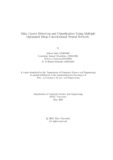Skin cancer detection and classification using multiple optimized deep convolutional neural network
Abstract
This work tries to detect skin cancer and classify its type using datasets containing
labeled images and classes, using pre-trained CNN models and merged
pre-trained CNN models. Skin cancer is an abnormal growth of skin cells that
most usually occurs on sun-exposed skin, although it can also develop in areas
of your skin that are not normally exposed to sunlight. Skin cancer is a kind
of malignant melanoma, which is a type of cancer. Melanoma, basal cell carcinoma,
and squamous cell carcinoma are the three types of skin cancer that
are diagnosed most frequently. According to projections made by the American
Cancer Society (ACS), the number of newly diagnosed cases of melanoma in the
United States would reach around 99,780 in the year 2022. (about 57,180 in
men and 42,600 in women). It has been estimated that around 7,650 persons
are at danger of passing away as a direct result of melanoma (about 5,080 men
and 2,570 women). In 2022, the United States expected to see 99,780 new cases
of melanoma, 101,280 non-invasive (in situ) cases, and 106,110 invasive cases.
Bangladesh is at 183 in the world rank. Skin cancer claims the lives of about 301
persons each year. Basal cell carcinoma is the most common type of skin cancer
(also known as basal cell skin cancer).More than 80 percent of all cases of skin
cancer are caused by basal cell carcinomas. The basal cell layer, which is located
in the lowest section of the epidermis, is where these cancers start. It will be
quite difficult to attain high accuracy if you rely just on the dataset that was
received from Kaggle. Take into consideration that not all datasets are balanced.
This paper therefore focuses on finding different techniques to achieve the most
accuracy on both large and small datasets with the help of Deep CNN models
such as VGG19, VGG16, ResNet50, InceptionV3 and combining two deep CNN
models. These techniques primarily rely on supervised learning, which leverages
datasets taining data points and labels. Here, we have merged various pretrained
models such as the VGG19, VGG16, ResNet50 and InceptionV3 and have passed
it into our CNN model. Moreover, we have used image inputs as 224 x 224 pixels.
Furthermore we have used Keras pre-process input applications with the
help of image data generator. Skin cancers images illustrate variations in different
characteristics. Evaluation of the results of the segmentation algorithm can
be equally complex. There will be a calculator that calculates the percentage of
loss. There is possibly various clinical attributes that points out the skin cancer
and classify its type.

